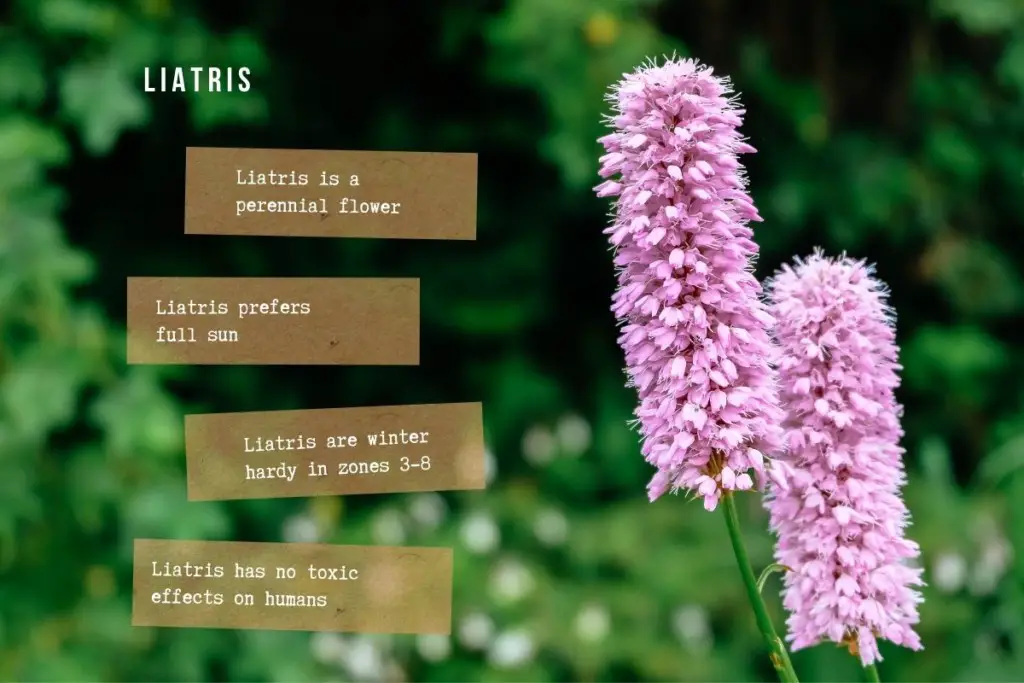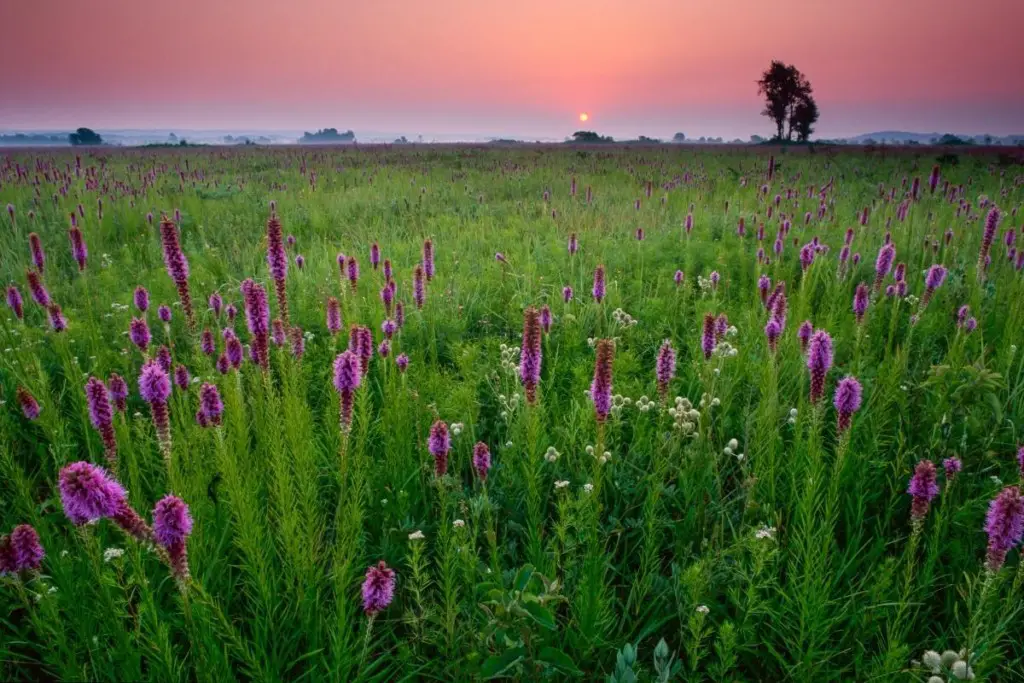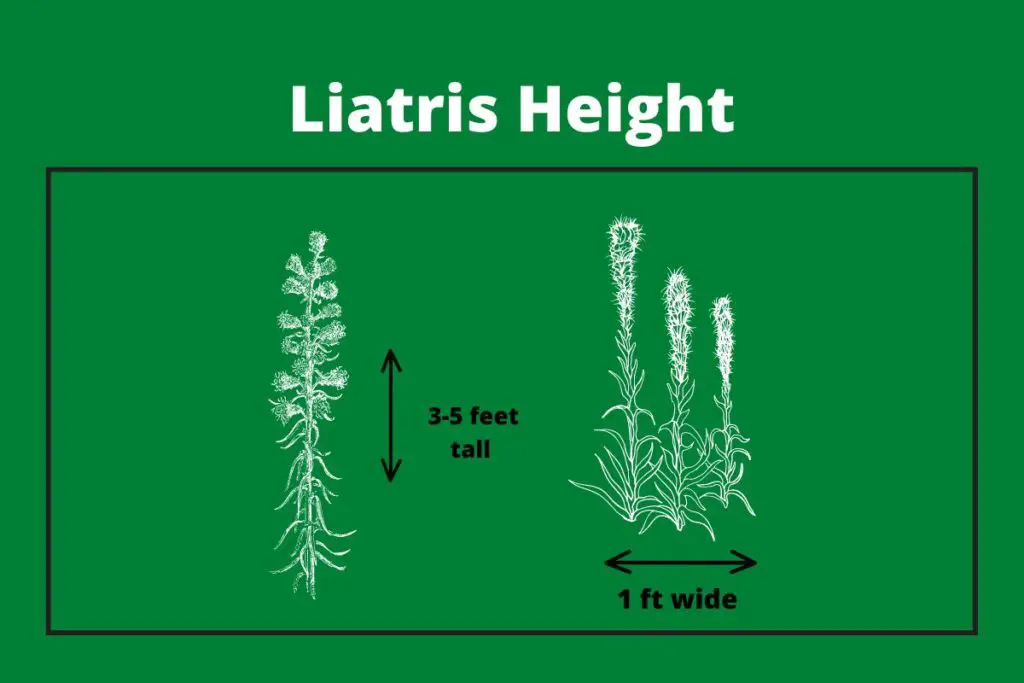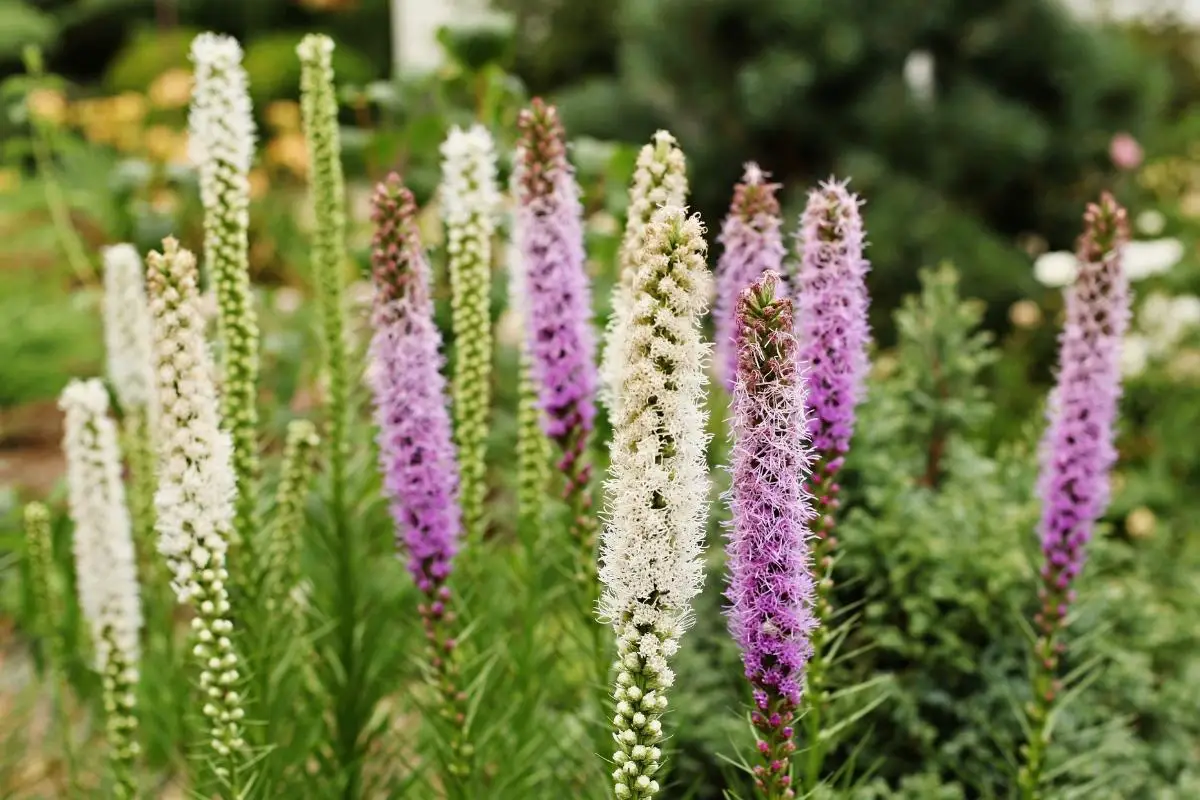Liatris (also known as Liatris spicata) is commonly found in the Eastern portions of North America. In terms of appearance, many people will immediately identify the bright purple colors that are associated with this species of plant. It can be found all across the Eastern United States and Eastern Canada.
Table of Contents
What is Liatris?
Liatris is a clump-forming perennial commonly found adjacent to prairies and other similar environments. It usually measures to be about three feet in height, but there have been instances where the height has been slightly larger. This plant experiences the most prosperity and blooms in late-Summer, usually from the end of June through early September.
The fluffy flower heads are vibrant and leafy, oftentimes attracting butterflies and other insects. It’s not uncommon for a large collection of birds to also be attracted to Liatris spicata. While prairies are the most common place to find this species of plant, it’s worth noting that it can prosper just about anywhere, under the right conditions.
The Liatris is a perennial plant and flower.
Liatris Scientific Name
This species of plant requires a lot of sunlight and a sufficient amount of water. While its natural maintenance is not significant, it still needs to live in reasonable conditions to survive.
| Scientific name: | Liatris |
| Family: | Asteraceae (Daisy Family) |
| Kingdom: | Plantae |
| Planting Distance: | 1’ to 1.5’ apart |
Remarkably, Liatris has been recognized for its incredible tenacity to survive during dry conditions. Liatris can even survive moderate droughts during the summertime.
What is the Common Name for Liatris?
The common name for Liatris is blazing star. While blazing star is the common name for Liatris, it can also be known as Liatris spicata, blazing star, and gayfeather. Its common name may depend on the region where you live. Where I live, in Texas, we call them blazing stars.
More common names for Liatris:
- Blazing Stars
- Dense Blazing Star
- Dense Button Snakeroot
- Gayfeather
- Marsh Blazing Star
- Sessile-headed Blazing Star
- Snakeroot
- Spike Gayfeather
Liatris is a great flower for large planting projects. They blend well with other vibrant colors and can be used as a border flower. Source.
There is more than one variety of Liatris, including the smaller dwarf “kobold” variety which is smaller and shorter.
See article Liatris Spicata Kobold
See our article for Liatris Companion Plants

Where Does Liatris Most Commonly Grow?
You will find a lot of Liatris spicata in prairie regions near the Eastern United States. The states that have the most of this plant species include:
- Florida
- Lousiana
- Michigan
- Illinois
Pennsylvania and Wisconsin are also high on the list of where Liatris spicata is most likely to grow, and it wouldn’t be wrong to include Missouri either.
So, what do all of these states have in common? From a geographical perspective, they’re all located east of the center of the North American continent. This plant species loves to grow and thrive in the prairies of North America, mainly because the conditions in this part of the country are ideal for this particular plant.
Several regions within Canada’s borders include environments where Liatris can thrive. The Liatris is a beautiful flower, that has vibrant colors. They are very easy to identify and are easy to grow and maintain in regions where it thrives.
Liatris grows from seeds, and corms, although, even though they are correctly called corms, they are also called bulbs interchangeably.
See our article When to Plant Liatris Bulbs

How Does Liatris Spread and Grow?
Liatris can spread fairly easily by self-seeding from the tip of the flower stalks. This marvelous lavender-colored flower is a popular garden choice due to its vibrance and sustainability, while also being relatively low in overall maintenance.
The self-seeding method of expansion for Liatris usually works the best during the early-Summer in temperatures near 60 degrees Fahrenheit.
As an alternative, Liatris can spread underground by expanding its corms. Both methods are sufficient and can be used depending on local environmental conditions.
See our article for growing Liatris from Seeds
See our article for Liatris Corms
What Does Liatris Look Like?
It can be pretty easy to identify Liatris because it’s so vibrant and unique. You’ll find this flower blooming in warm temperatures during the summertime, presenting itself with sharp purple and lavender colors. However, there are also other colors, such as white, that pair well with the purples.
It has earned the nickname ‘blazing star’ due to its unique appearance and how it oftentimes looks like a shooting star from a distance.
To learn how to grow Liatris see our article Liatris Care
See our article for Liatris Bloom Time
Liatris Height
How tall does Liatris get? In terms of size and length, Liatris can span to a size of 3 or 6 feet in overall height. The spikes of the flower can even reach higher up in some circumstances, but most commonly range around the 3-to-4-foot threshold.
Because these are prairie flowers, they can thrive with very little maintenance, if they have perfect conditions. If there is not enough rain, you will have to consider watering them. If you want them to get tall they need enough water to support that growth. Source.
Be careful not to keep them too wet. They may grow taller, but the wet soil can cause them to fall over. Your beautiful Liatris, that you helped get so tall, will lean and fall and be hard to handle and nobody wants that.
Liatris height can depend on the type of variety you have. For instance, a kobold Liatris is a dwarf version of the plant. So the stalks are much shorter.
Liatris Flower Height Chart
| Liatris Height | 3-6 feet in height |
| Kobold Liatris Height | 18-30 inches in height |
How Big Does Liatris Get?
Liatris spicata’s height and spread will depend on the conditions where they grow. In ideal conditions, they grow to be as tall as 6 feet, at about 1 ft wide but can spread to be wider.
Liatris can be planted together, and in doing so, you will get different variations in height. They can be fun flowers to fill in areas where uniformity is not a must. You can plant the kobold variety if you want them to be shorter. You could even plant a front row of Liatris kobold, with a taller row of Liatris spicata behind it.

While dark purple is the most common color that you’ll associate with Liatris, it’s actually also possible to have light pink and white flowers as well with this particular plant. The human eye isn’t the only thing drawn towards these remarkable flowers, because you’ll notice that a large number of butterflies will pay a visit to this remarkable perennial flower.
See our article White Liatris
For more varieties see Liatris Colors
Can Liatris Survive A Drought?
It’s always one of the early questions that you have to ask when taking an overall look at a specific plant in the wilderness. Liatris is capable of surviving droughts once it has had time to build up a sufficient root system underground.
If this root system is not developed, Liatris can struggle to survive in dryer conditions. Moderate droughts won’t hurt this plant species, but severe droughts will likely have a long-term negative effect on its survival chances.
If you are integrating Liatris into your garden, you should be prepared to water it at least once per week until it can develop a sufficient root system. After this system develops, Liatris can pretty much survive on its own with very little assistance.
Does Liatris Come Back Every Year?
Is Liatris a perennial? After Liatris has enough time for its root system to be established, it will come back for many years. Liatris is a perennial plant and flower that offers longevity. If you live in a region that is suited for this type of perennial, you can grow and maintain them for a very long time.
My favorite part about plants like Liatris that come back every year is that you can get them started pretty easily, and then enjoy them for years to come. If you want to add some color to your summer flowers, then this is a great plant and flower to consider.
There is some maintenance involved, which includes pruning them. Also called deadheading. This is done at the end of each bloom cycle.
See our article on Liatris Deadheading
FAQ
Poor soils are not the best for Liatris spicata, but sometimes they can still tolerate it and survive. Average soils and moist soils are the best-case scenarios for this particular plant species.
Yes, this is the most common location where you’ll find this particular plant species growing in the wilderness. The Eastern United States is an excellent location to search for Liatris.
There are no special requirements for winterizing your Liatris. The regular pruning back the stalks at the base is fine. You can also leave the stalks.

